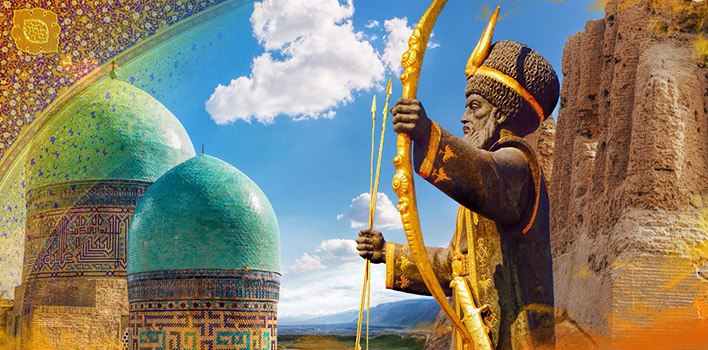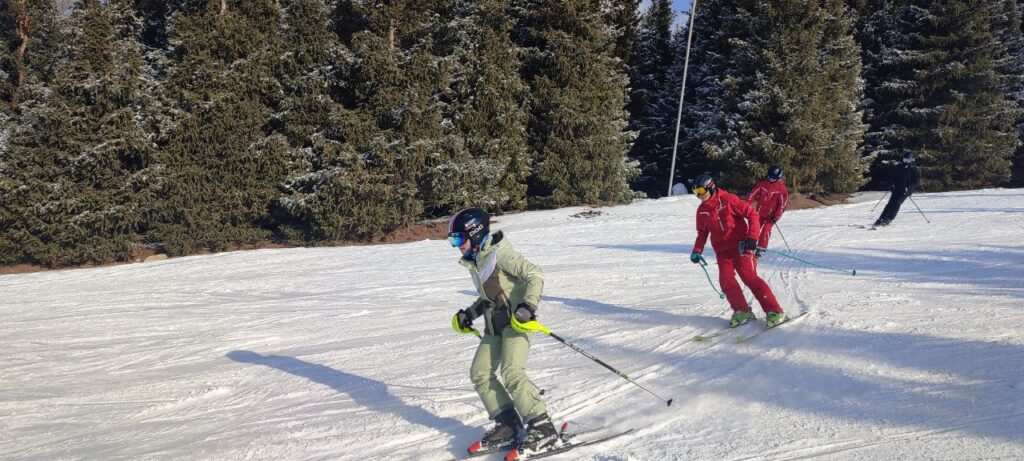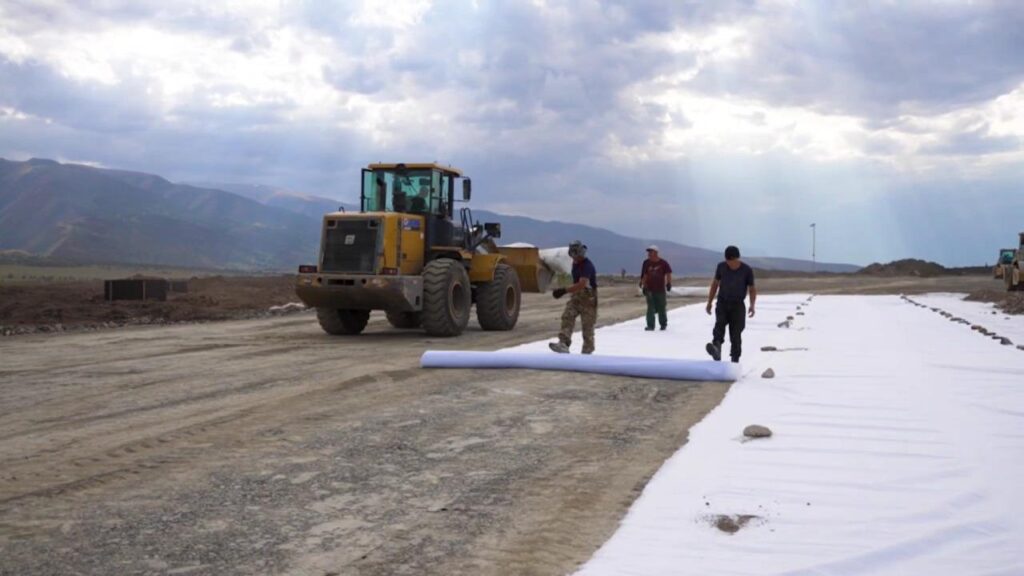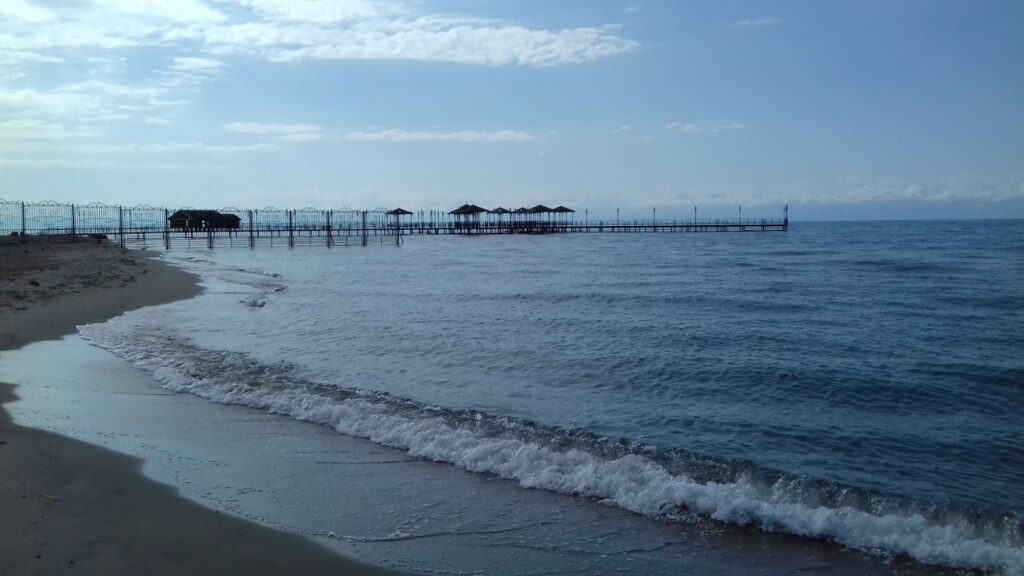Dotted with historical and cultural sites, and blessed with beautiful nature and a good climate, Turkmenistan is beginning to develop its tourism industry.
Turkmen authorities are expanding tourist itineraries, and improving the infrastructure and quality of services. Measures are also in place to provide a clean environment, safe drinking water and better food hygiene.
Turkmenistan has a variety of natural wonders. The unique landscapes of Kopetdag, the Karakum desert, the Amu Darya river, Koytendag, the subtropics of south-western Turkmenistan and the Turkmen coast of the Caspian Sea are ideal spots for ecological tourism.
The Aydere Gorge in western Kopetdag is also popular with travelers. Here there are dozens of picturesque valleys with pure springs, as well as ancient fortresses and historical monuments that guard the secrets of ancient times. Koytendag, located in the south-east of the country, attracts tourists seeking the traces of dinosaurs that lived here in prehistoric times.
The Sumbar Gorge in the south-west of the country also offers great opportunities for tourism development. Its beautiful mountain valleys, life-giving springs, and diversity of animal life make this place especially attractive.
The national tourist zone Avaza on the Caspian Sea coast attracts tourists from all over the world. Its comfortable climate, therapeutic mud, and mineral springs create ideal conditions for the development of ecotourism.
The Caspian Sea coast, with its amazing nature, changing in every season, impresses one with its beauty and charm.
Places that are also worth visiting in Turkmenistan:
Darvaza
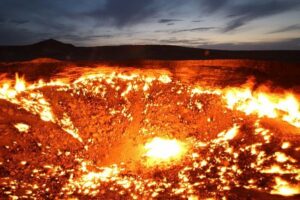
In the heart of Turkmenistan’s Karakum Desert is the Darvaza gas crater, which looks like a gateway to the underworld. The fire pit results from unsuccessful drilling conducted by Soviet geologists in 1971.
To prevent the natural gas from harming people and livestock, the geologists decided to set it on fire. The fire, which was supposed to go out in a few days, is still burning to this day. The tongues of flame, reaching ten meters in height, can be seen from several kilometers away. The crater is about 60 meters in diameter and 20 meters deep.
Darvaza is located 266 kilometers north of Ashgabat and 90 kilometers north of the village of Erbent.
Several sinkholes can be found in the vicinity of the crater; one of them is filled with a bright turquoise liquid.
The most impressive sight is Darvaza in the early evening light. Arriving before sunset, you can enjoy a fantastic contrast: the crater, bathed in the orange rays of the setting sun, gradually sinks into darkness, illuminating the desert landscape with bright flames. Other sinkholes are best viewed during daylight hours, but one should be careful as the loose earth near the edges crumbles and chunks of earth fall into the abyss. There is a strong smell of gas near the pit, and the temperature is quite high, so staying here for a long time is not recommended.
Yekedeshik
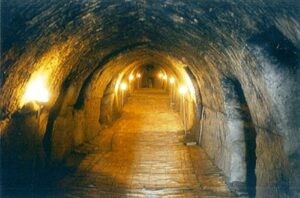
Yekedeshik, or “one hole,” is a mysterious cave city located near the village of Takhta Bazar in Mary province, on the left bank of the Murghab River. This two-level labyrinth of cave dwellings is a unique creation of ancient craftsmen.
The caves, united by a long gallery-corridor with a semi-cylindrical vault, are dug into clay sandstone at a height of 100 meters above the river. A single entrance leads to the underground city, which gives the place its name.
Yekedeshik is an understudied monument. Research on the site continues to this day. Scientists assume that it was created around the first century BC.
Researchers believe that in the early Middle Ages a large number of families lived here together, as the underground complex was a spacious enough and well-protected dwelling that was hidden from prying eyes. There are 44 caves in the complex.
Abiverd
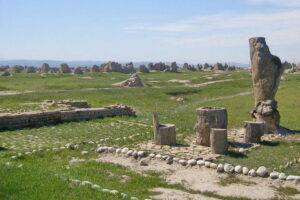
@advantour.com
Abiverd is a mysterious city located near the Turkmen town of Kaka, which was called Kaahka until the end of the 20th century.
This rare archaeological monument, dating back to the Sassanid era, bears the romantic name Abiverd. The ancient city was part of the frontier line of Iranian cities that held back the onslaught of barbarian tribes deep into Inner Asia.
Excavations have shown that fierce battles took place near the walls of Abiverd. Historical sources mention it as a rural settlement with a warlike population due to its border location.
Gonur-Depe
In 1974, archaeological excavations of a unique urban settlement of the Bronze Age, known as Gonur-Depe, began in south-eastern Turkmenistan.
The excavations uncovered amazing structures, including majestic temples and a large city palace. This indicates that Gonur-Depe was a major metropolitan center with a developed culture.
The inhabitants of Gonur-Depe practiced Zoroastrianism. Archaeological finds confirm the active trade of the city with the states of the East. Seals from Mesopotamia, locally produced clay vessels, and various types of luxurious jewelry were found within the settlement.
Lake Kov-Ata
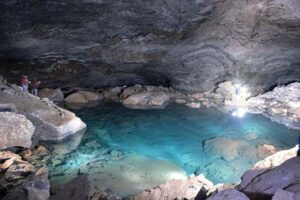
Located 60 kilometers west of Ashgabat, in the famous Baharden Cave, there is an underground lake, Kov-Ata, which means “father of caves” in Turkmen.
The descent into the cave begins with a steep staircase. At a depth of 60 meters you can see a small part of Kov-Ata Lake.
The water of Kov-Ata Lake is rich in minerals, including iodine, magnesium, iron, bromine, potassium, sodium, sulfate, and other elements.
There is a legend that during the Parthian kingdom, mortally wounded rebellious slaves were healed in the lake’s waters.
Ancient Merv
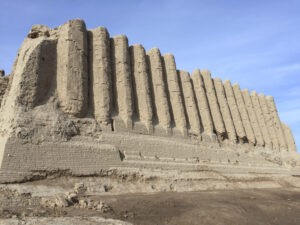
The Merv oasis is one of the most ancient regions of Central Asia, where irrigation was mastered in ancient times. It is not surprising that one of the largest cities of the ancient world, Merv, emerged there.
The first written references to the city are found in the Avestan chronicles, which date back to the 8th and 7th centuries B.C. Chroniclers called it “the soul of the king,” “the mother of the cities of Khorasan,” and “the city on which the universe rests.”
Great thinkers of the Middle Ages lived and worked here, including Omar Khayyam, As-Samani, and Imamaddin-Isfahani.
The modern ruins of Merv include five ancient settlements: Erk-Kala, Gyaur-Kala, Sultan-Kala, Abdullahan-Kala, and Bayramalikhan-Kala. Most of them are badly destroyed, and some are left only as crumbling mounds of earth, but even with this, Merv remains one of the most unique monuments of history.
